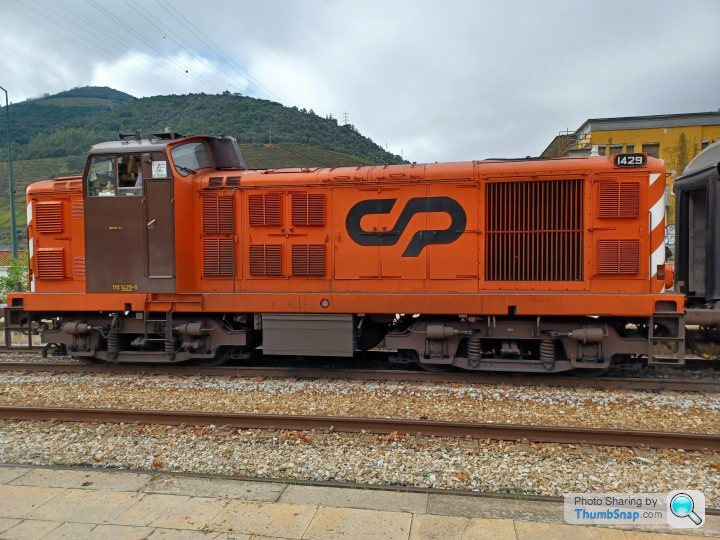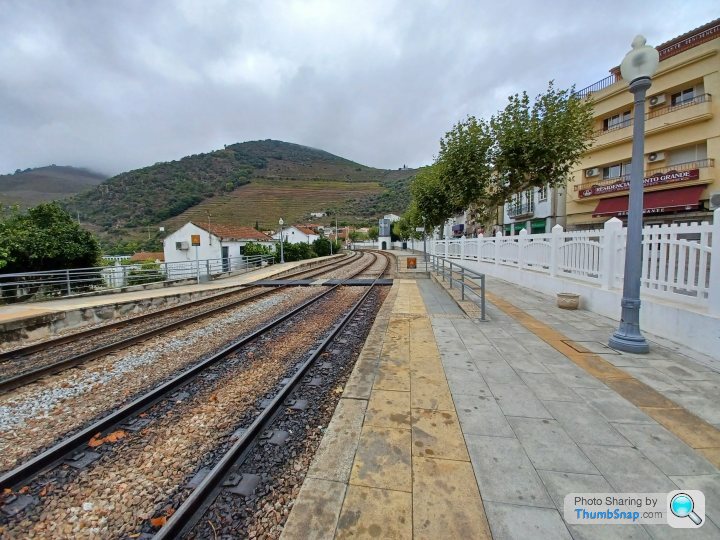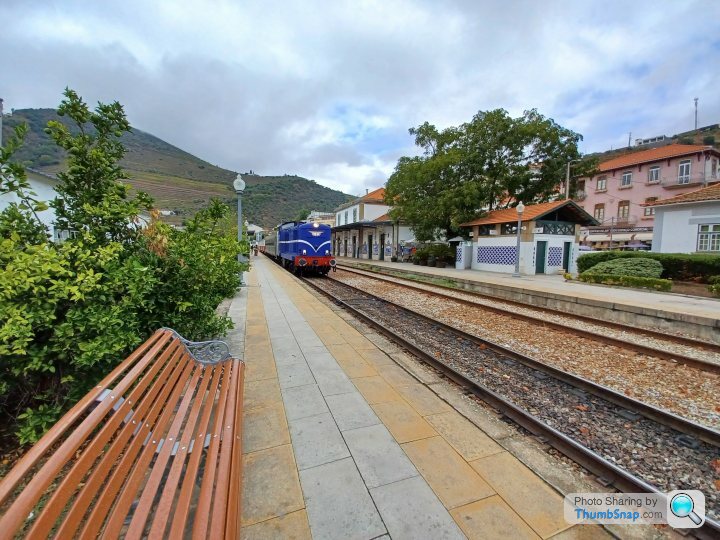Portuguese broad gauge.
Discussion
Venisonpie said:
I'm in the Douro Valley for a few days and decided to take a scenic rail journey which has been spectacular. To my untrained eye the track gauge looks a bit wider than UK standard gauge?
Yes, it'll be 'Iberian' broad gauge - 5ft and nearly-6in (1668mm). Spain and Portugal originally had different gauges because they also had different measuring systems - Spanish railways were built to six 'Castille feet' (5ft 5-and-a-bit inches) and Portuguese ones were originally standard gauge and then built to to five 'Portuguese feet' (5ft six inches). In the 1950s the two nations introduced a standard 'Iberian gauge' that was between the two.It's one of the differences that proved a challenge for the Germans in WW2. Their expansionist dreams kept running into railways of the wrong gauge.
Check out the old and once grand Canfranc station in the Pyrenees,
https://en.wikipedia.org/wiki/Canfranc_Internation...
"Extensive infrastructure was present to service and transfer transiting passengers, baggage and freight between Spanish and French trains, because the French rail standard gauge of 1,435 mm (4 ft 8+1⁄2 in) was incompatible with the Spanish gauge of 1,668 mm (5 ft 5+21⁄32 in) at the time, and hence prevented through traffic."
And similar in the Soviet Union, with its 5-foot gauge.
Check out the old and once grand Canfranc station in the Pyrenees,
https://en.wikipedia.org/wiki/Canfranc_Internation...
"Extensive infrastructure was present to service and transfer transiting passengers, baggage and freight between Spanish and French trains, because the French rail standard gauge of 1,435 mm (4 ft 8+1⁄2 in) was incompatible with the Spanish gauge of 1,668 mm (5 ft 5+21⁄32 in) at the time, and hence prevented through traffic."
And similar in the Soviet Union, with its 5-foot gauge.
Panamax said:
It's one of the differences that proved a challenge for the Germans in WW2. Their expansionist dreams kept running into railways of the wrong gauge.
Check out the old and once grand Canfranc station in the Pyrenees,
https://en.wikipedia.org/wiki/Canfranc_Internation...
"Extensive infrastructure was present to service and transfer transiting passengers, baggage and freight between Spanish and French trains, because the French rail standard gauge of 1,435 mm (4 ft 8+1?2 in) was incompatible with the Spanish gauge of 1,668 mm (5 ft 5+21?32 in) at the time, and hence prevented through traffic."
And similar in the Soviet Union, with its 5-foot gauge.
In both cases a deliberate strategic choice. Russia and Spain both made the decision to retain non-standard rail gauges to provide an obstacle to foreign invaders - in Spain's case by making it much harder for a French invader to move men and materiel through the Pyrenees and in Russia's case to make bottleknecks for any east-going Prussians and/or Austrians. Check out the old and once grand Canfranc station in the Pyrenees,
https://en.wikipedia.org/wiki/Canfranc_Internation...
"Extensive infrastructure was present to service and transfer transiting passengers, baggage and freight between Spanish and French trains, because the French rail standard gauge of 1,435 mm (4 ft 8+1?2 in) was incompatible with the Spanish gauge of 1,668 mm (5 ft 5+21?32 in) at the time, and hence prevented through traffic."
And similar in the Soviet Union, with its 5-foot gauge.
The Russian Empire also deliberately didn't develop the rail network around the Vistula (when that area was Russian imperial territory), because it was predicted to be the main battlefield of a future Prussian/Russian war, with the Vistula planned to be the main Russian logistical centre. But the Russian General Staff didn't want to potentially gift any advancing German Army a well-developed hub of railways spreading off into the heart of Mother Russia, so the network was centrally planned to deliver military traffic to the edge of the Vistula but not into it.
Panamax said:
It's one of the differences that proved a challenge for the Germans in WW2. Their expansionist dreams kept running into railways of the wrong gauge.
Check out the old and once grand Canfranc station in the Pyrenees,
https://en.wikipedia.org/wiki/Canfranc_Internation...
"Extensive infrastructure was present to service and transfer transiting passengers, baggage and freight between Spanish and French trains, because the French rail standard gauge of 1,435 mm (4 ft 8+1?2 in) was incompatible with the Spanish gauge of 1,668 mm (5 ft 5+21?32 in) at the time, and hence prevented through traffic."
And similar in the Soviet Union, with its 5-foot gauge.
In both cases a deliberate strategic choice. Russia and Spain both made the decision to retain non-standard rail gauges to provide an obstacle to foreign invaders - in Spain's case by making it much harder for a French invader to move men and materiel through the Pyrenees and in Russia's case to make bottleknecks for any east-going Prussians and/or Austrians. Check out the old and once grand Canfranc station in the Pyrenees,
https://en.wikipedia.org/wiki/Canfranc_Internation...
"Extensive infrastructure was present to service and transfer transiting passengers, baggage and freight between Spanish and French trains, because the French rail standard gauge of 1,435 mm (4 ft 8+1?2 in) was incompatible with the Spanish gauge of 1,668 mm (5 ft 5+21?32 in) at the time, and hence prevented through traffic."
And similar in the Soviet Union, with its 5-foot gauge.
The Russian Empire also deliberately didn't develop the rail network around the Vistula (when that area was Russian imperial territory), because it was predicted to be the main battlefield of a future Prussian/Russian war, with the Vistula planned to be the main Russian logistical centre. But the Russian General Staff didn't want to potentially gift any advancing German Army a well-developed hub of railways spreading off into the heart of Mother Russia, so the network was centrally planned to deliver military traffic to the edge of the Vistula but not into it.
2xChevrons said:
In both cases a deliberate strategic choice. Russia and Spain both made the decision to retain non-standard rail gauges to provide an obstacle to foreign invaders
The oddity is that they both went in the wrong direction. It's remarkably straightforward to move one of the rails inwards a few inches but much more difficult to replace every sleeper with a longer one. Similarly the loading gauge isn't likely to be any problem (clearance under bridges, in tunnels and between opposite tracks).Start out with a narrow gauge system and try to widen it to standard gauge and you're in all sorts of trouble.
Australia is fun:
Queensland - mainly narrow gauge
New South Wales - standard
Victoria - standard and broad
South Australia - standard
Northern Territory - standard
Western Australia - narrow and standard
Most of the standard gauge stuff is the long interstate lines. Victorian regional / metro lines are broad gauge.
https://en.m.wikipedia.org/wiki/Rail_gauge_in_Aust...
Queensland - mainly narrow gauge
New South Wales - standard
Victoria - standard and broad
South Australia - standard
Northern Territory - standard
Western Australia - narrow and standard
Most of the standard gauge stuff is the long interstate lines. Victorian regional / metro lines are broad gauge.
https://en.m.wikipedia.org/wiki/Rail_gauge_in_Aust...
Thanks for the gauge education!
A bit of quick research shows the locomotives used here are class 1400's based on English Electric Class 20's. Apparently the initial ones were built in the UK with assembly transferring to Portugal thereafter.
Interesting position of the exhaust.

A bit of quick research shows the locomotives used here are class 1400's based on English Electric Class 20's. Apparently the initial ones were built in the UK with assembly transferring to Portugal thereafter.
Interesting position of the exhaust.

Edited by Venisonpie on Wednesday 13th September 07:32
Gassing Station | Boats, Planes & Trains | Top of Page | What's New | My Stuff






